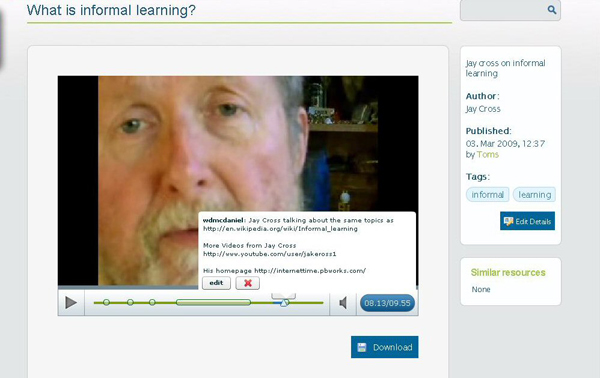Leveraging Informality Within eLearning
urn:nbn:de:0009-5-20086
Abstract
The next generation of learners expect more informality in learning. Formal learning systems such as traditional LMS systems no longer meet the needs of a generation of learners used to Twitter and Facebook, social networking and user-generated content. Regardless of this, however, formal content and learning models are still important and play a major role in educating learners, particularly in enterprise. The eLite project at DERI addressed this emerging dichotomy of learning styles, reconciling the traditional with the avant garde by using innovative technology to add informal learning capabilities to formal learning architectures.
Keywords: e-learning; social networks; informal learning; user generated content, web 2.0, eLite project
Informal learning has been defined as “any activity involving the pursuit of understanding, knowledge or skill which occurs without the presence of externally imposed curricular criteria” [1] This definition covers a wide range of student activity, from casual conversation, to intentional, but unstructured or unguided browsing of resources on the web.
Informal learning in the 21st century has grown to include instant messaging, chat rooms, blogs, wikis, user forums, video and audio blogging, and other modern communication technologies. The advent of Web 2.0 technologies and social networking systems has migrated traditional informal learning from the mentor in the next door office to the mentor in the company’s offices halfway around the globe. Informal learning today may also include information and advice from outside the enterprise. Communities of practice, friend of a friend networks, self-selecting collections of users, and information from sources outside the enterprise may be used by informal learners.
To date, eLearning has focused on more formal learning methods such as structured courses and workshops. These types of courses account for only 20% of what we learn in the workplace while consuming up to 80% of the training budget [2]. Corporate training departments feel safe with formal training as it provides certification and tangible results. However, informal learning, or unstructured, impromptu and unscheduled learning accounts for up to 80% of our actual workplace learning.
The eLite project at DERI merged both formal and informal learning into a single SCORM compliant delivery platform, empowered with what are now considered to be the standard tools of the new generation of worker for communicating and learning; user generated content as represented by social networking sites, annotated content, chats, wikis, blogs, and forums.
This Net Generation [3] (Gen Z, iGen, or even Cold Y Gen) shows specific activity signatures with respect to learning new skills and dealing with new social and work situations. For example, 97% own a computer, 94% own a mobile phone, and 56% own a digital music player [4] eLite addressed these Net Gen learners by providing a formal content player, coupled with the ability to add user generated informal learning content in the form of “LearnLet” notes on course pages, videos, audio, and other media that allow users to communicate instantly or through traditional postings with other users. A user-created LearnLet on a video clip is illustrated in Figure 1, in this example the user has shared links to related informal learning sources including Wikipeida and YouTube with the wider community.

Figure 1: Sharing informal learning sources with LearnLets
In addition to LearnLets, eLite also provides an Amazon.com-like rating and recommendation facility for allowing users to select future lessons and content based on what other learners have indicated were the best for an intended purpose.
eLite provided expert finding capability via a built in facility which mined informal and social content associated with registered learners in the community. Where interests are shared and knowledge transfer has occurred, innovative graphical visualisers show learners this and point them to people who can offer advice via the communication channels they are used to.
Through it’s combination of social networking and formal learning content eLite successfully exploited the informal learning potential within communities. Initial evaluations of the informal learning opportunities within eLite have been promising with users finding the informal capabilities of the technology to be positive and helpful.
Further information about the project can be found at the project website:
http://elite.deri.org/
[1] Livingstone, D.W.: Adults' Informal Learning: Definitions, Findings, Gaps and Future Research. In: Toronto: OISE/UT, NALL Working Paper No.21, 2001. online: http://www.oise.utoronto.ca/depts/sese/csew/nall/res/21adultsifnormallearning.htm (last check 2009-07-14).
[2] Cross, Jay: Informal Learning: Rediscovering the Natural Pathways that Inspire Innovation and Performance. Pfeiffer, San Francisco, 2006. online:
[3] http://en.wikipedia.org/wiki/Generation_Y (last check 2009-07-14)
[4] Junco, Reynol; Mastrodicasa, Jeanna M.: Connecting to the Net.Generation: What higher education professionals need to know about today's students, 2007